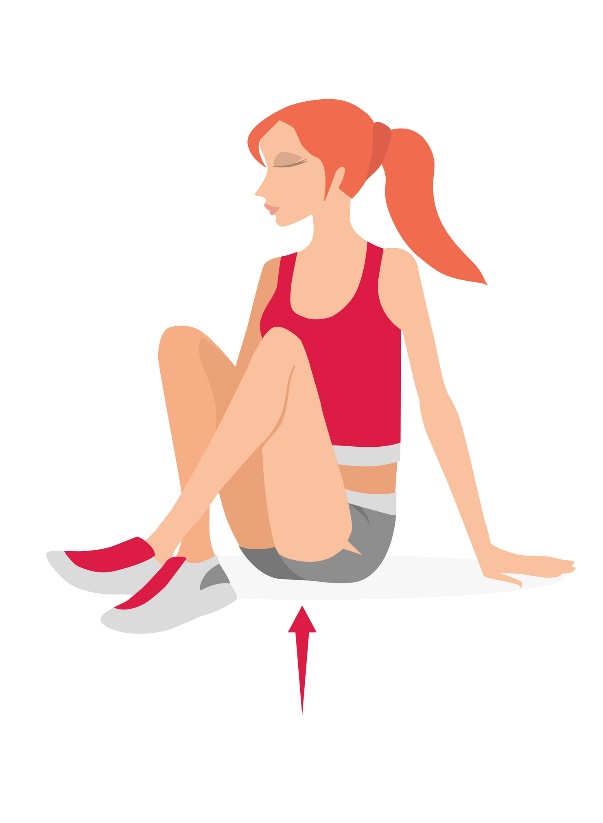- ROZTOČIL, Aleš and Pavel BARTOŠ. Modern Gynaecology. Prague: Grada, 2011. ISBN 978-80-247-2832-2
- KOLÁŘ, Pavel. Rehabilitation in clinical practice. Second edition. Prague: Galén, [2020]. ISBN 978-80-7492-500-9
- healthline.com - Kegel Exercises. Healthline. Debra Stang
- medicalnewstoday.com - How to do pelvic floor exercises. Medical News Today. Rachel Nall, MSN, CRNA
Kegel exercises: activating and strengthening the pelvic floor + 5 exercises to do at home

A weakened pelvic floor can cause a number of health complications. Both women and men can experience reduced pelvic floor function throughout their lives. What are the appropriate exercises to activate the pelvic area?
Article content
Pelvic floor muscles are very important for the position, stability and mobility of the small pelvic organs.
They also play a role in the actual experience of sexuality and intercourse.
What are the causes of its dysfunction, the possibilities of therapy and specific exercises that can be performed at home? The answers to the questions and a lot of interesting information can be found in the article.
The pelvic floor
Thepelvic floor (diaphragm pelvis) is made up of a group of muscles that together form a functional closure of the pelvic cavity. Their shape resembles a bowl.
The pelvic floor serves to maintain proper stability and mobility of the internal organs and influences their physiological position and function.
Part of the pelvic floor forms the outlet of the genital, excretory and digestive systems. Muscles influence the correct position of the bladder, rectum and organs of the genital system.
In women, the pelvic floor has an important stabilizing and protective function during pregnancy.
The importance and function of the pelvic floor:
- Correct position of the pelvic organs
- Stability of the pelvis and pelvic cavity
- Part of the body's stabilization system
- Influence on blood circulation and organ function
- Opening and closing of the sphincters
- Experiencing sexuality and intercourse
- Function during pregnancy and childbirth
When the pelvic floor is weakened and dysfunctional, there can be a decrease in pelvic organ stability, weakening of the sphincter muscles and a decrease in blood flow to the area.
This can result in pelvic organ sagging, pelvic pain, urinary leakage (incontinence), uncomfortable intercourse, erectile weakness, disruption of the menstrual cycle or digestive difficulties in terms of problems with stool elimination.
Weakening of the pelvic floor can occur as a result of pregnancy and childbirth, prolonged physical inactivity, muscular imbalances of the pelvic area, frequent pelvic inflammatory disease, excess weight, post-operative inactivity or as a result of mechanical damage and trauma.
To prevent health and eliminate pelvic floor problems, it is advisable to include conscious activation of the pelvic floor in physical activity. A suitable and simple variant is the Kegel exercise.

Kegel exercises
Kegel exercises originated in the early 1920s. The American physician Arnold Kegel invented the exercises as a method of treating postpartum women with incontinence.
Subsequently, the exercises have evolved and currently address a number of pelvic floor related diagnoses.
These specific exercises activate, strengthen and also stretch the pelvic muscles.
The goal is to promote pelvic stability, abdominal musculature, control intra-abdominal pressure, increase blood circulation to the organs, pelvic floor flexibility, and thus eliminate the health problems that arise.
Kegel exercises and their effects:
- Strengthening the pelvic floor muscles
- Strengthening the abdominal and gluteal muscles
- Regulating intra-abdominal pressure
- Eliminate pelvic pain
- Stabilization of the pelvic cavity and trunk
- Elimination of urinary and faecalincontinence
- Harmonization of the menstrual cycle
- Supporting the experience of sexuality
Kegel exercises and men
Kegel exercises are not only suitable for women, but also for men. Men who are struggling with prostate disorders, erectile dysfunction or other urological problems should also take note.
By increasing blood circulation, the exercises promote erectile function in men.
According to Kegel, anyone who has a sedentary job, suffers from back pain or some form of incontinence - urinary leakage - should strengthen their pelvic muscles.
Kegel exercises and women
Kegel exercises are especially important for pregnant women, women after childbirth, after gynaecological surgery and also for menopausal women.
Last but not least, Kegel exercises help women to retain urine and prevent incontinence. Urinary leakage often starts slowly, with only a slight leakage of urine when sneezing or coughing.
Unfortunately, incontinence affects many women today, especially older women and women in the postpartum period.
Thanks to Kegel exercises, women can better control the muscles of the vaginal tube and thus better stimulate their partner during intercourse.
Exercise rules
Both men and women should perform the Kegel exercises regularly 3 times a day (15 minutes in total).
Certain positive results can be felt after the exercises themselves. Progress is quite rapid with Kegel exercises.
The Kegel exercises consist of rhythmic contraction of the pelvic floor and subsequent relaxation. Initially, short contractions are sufficient and gradually the length of the contractions is extended to ten seconds or more.
The rule is not to hold your breath and to perform regular diaphragmatic breathing.
5 simple exercises you can do at home
Below are shown and described 5 examples of exercises inspired by Arnold Kegel. However, we recommend a professional consultation with a physiotherapist who will show you the exact routine, the correct technique and point out any mistakes in the exercises.
The exercise technique consists of contracting and relaxing the pelvic floor, gradually increasing the length of the contractions.
The breathing is smoothly directed mainly to the diaphragmatic abdominal region.
Help:
Pelvic floor contraction is the sensation of clenching the pelvic floor muscles and the internal sphincters (as when holding a small and large need simultaneously).
Exercise 1 - pelvic floor activation in the supine position
- The basic position is lying on the back with the lower limbs bent at the knees. The feet of the lower limbs are glued full length to the mat. The knee joints are level with the width of the hip joints. The spine is resting on the mat and the head is in direct extension. The arms are pulled away from the ears and the hands are loosely lowered by the body.
- With the exhalation, the pelvic floor is activated - contraction of the muscles and sphincters imaginatively inwards.
Remain in the position and breathe freely. With the inhalation comes the relaxation and release of the pelvic muscles. - During the exercise, the pelvic floor can be contracted in isolation or with the activation of the gluteal muscles. As an aid to check technique, it is advisable to place the hands over the pelvis and under the gluteal muscles.
Mistakes: holding the breath, not activating the pelvic floor, loose space between the spine and the mat.

Exercise 2 - pelvic floor activation in the bridge
- The basic position is lying on the back, similar to the first exercise. The knee joints are bent, the shoulder blades rest flat on the mat. There is no space between the spine and the mat. The knee joints are level with the width of the hip joints. The arms are loosely placed along the body, the palms facing down. The arms are again lowered away from the ears.
- During the exercise, the pelvis is gradually and smoothly lifted upwards towards the ceiling. The shoulder blades remain supported throughout the exercise. In the upper position of the bridge, the pelvic floor is activated - contraction of the internal muscles of the pelvic floor and contraction of the buttocks. In the upper position, the abdominal wall is held, tightening over the diaphragm several times. With an exhalation, the practitioner lowers the mat again and relaxes the musculature of the whole body.
Mistakes: sagging in the lumbar spine, not activating the pelvic floor, holding the breath in the upper position.

Exercise 3 - activation of the pelvic floor while lying on the stomach
- The basic position is lying on the stomach. The practitioner has the upper and lower limbs extended apart. The forehead rests on the mat and the head is in direct extension of the spine. The arms are freely extended away from the ears. There is no free space between the mat and the body.
- With the exhalation, the pelvic floor is activated, the sphincters contract and the pelvic floor muscles are imaginatively activated towards the upper limbs. With the inhalation, the practitioner releases the activated muscles.
- As an aid to activate the posterior muscle chain, it is advisable to bend one lower limb at the knee joint.
Mistakes: holding the breath, loosening the abdominal wall, not activating the pelvic floor.

Exercise 4 - Pelvic floor activation in the prone position
- The basic position is on all fours on a soft mat. The hands are palms down at shoulder-width joints. The knee joints are approximately the width of the pelvis and the thigh bones form an imaginary right angle with the torso. The spine is flexed with the head and in an increased lordosis.
- From the first position, there is a smooth transition with exhalation to the second position. The practitioner arches the back as far as possible and lowers the head loosely over the shoulders down onto the mat. With exhalation, there is an inward contraction and activation of the pelvic floor muscles and sphincters.
- With an inhalation, the practitioner returns to the first position while relaxing the activated muscles. There is a smooth movement from one extreme position to the other.
Faults: rapid oscillating movements, irregular breathing, non-activation of the pelvic floor.

Exercise 5 - pelvic floor activation while sitting
- The basic position of the exercise is seated with the back and head erect. The upper limbs are extended and the palms rest slightly on the mat. The lower limbs are bent at the knee joints and crossed in an imaginary Turkish sit.
- With the exhalation, the pelvic floor is activated, the pelvic floor muscles and sphincters contract inwards and upwards towards the ceiling. With the inhalation, the activated pelvic floor muscles are then released.
Faults: not activating the pelvic floor and sphincters, not sitting upright, irregular breathing.

Interesting resources










